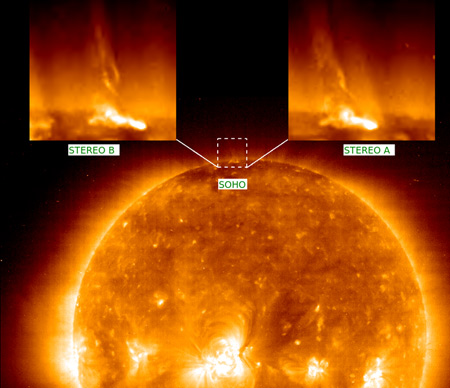Solar physicists have for years theorized that violent outbursts from the sun have their roots in contorted loops of magnetic field that rise up from the sun’s visible surface, suddenly snap like rubber bands and then reconnect with neighboring fields. Researchers now report that they have some of the first graphic evidence in support of this twisted thinking.

Using NASA’s twin STEREO spacecraft like a pair of eyes, each staring at the sun from a different perspective, researchers have constructed the first 3-D image of a jet of gas zooming out of the sun’s outer atmosphere. The jet’s helical shape provides strong evidence that the outburst was generated by twisted magnetic fields anchored in the sun’s visible surface, or photosphere, Spiros Patsourakos of George Mason University in Fairfax, Va., and his colleagues report in an upcoming Astrophysical Journal Letters. They will also describe the findings later this month in Fort Lauderdale, Fla., at the spring meeting of the American Geophysical Union.
Extreme-ultraviolet telescopes on the STEREO craft observed the jet shooting out of the polar region of the sun’s outer atmosphere, or corona, in June 2007. One of the craft viewed the polar jet face-on, the other edge-on, and together they reveal the jet’s corkscrew pattern. Another jet observed by the STEREO pair this past January, after the team had submitted their paper, also shows the helical shape, Patsourakos told Science News.
Polar coronal jets, first discovered by the Japanese X-ray spacecraft Yohkoh in 1996, are now known to erupt from the sun several times an hour and are an important contributor to solar wind, the stream of charged particles that blows out from the sun.
The jets are not directly related to more dramatic solar outbursts, such as coronal mass ejections, the billion-ton magnetic clouds of charged particles that can damage satellites and disrupt power grids when they pass near Earth. But all of these solar temper tantrums, Patsourakos notes, are thought to stem from the same physical process: reconnection of magnetic fields of opposite polarity.
“Given the relative simplicity of jets, understanding them could prove to be the Rosetta Stone for understanding the larger-scale eruptions,” such as flares and coronal mass ejections, Patsourakos says.
The observations confirm a model previously outlined by study coauthor Spiro Antiochos of NASA’s Goddard Space Flight Center in Greenbelt, Md., and his collaborators. In that model they proposed that the energy stored and then suddenly released in the twisted magnetic fields propel the jet of gas upward, imparting the helical pattern. When the fields totally unravel, some of the gas may fall back toward the sun, but other parcels, revved up to velocities greater than 300 kilometers per second, escape the corona and head into space.
“It’s fabulous. It’s a great result,’ comments Craig DeForest of the Southwest Research Institute in Boulder, Colo. In some previous models, he notes, it was hard to understand how a twisted magnetic field could generate the pressure required to expel a jet of gas from the sun.
That’s because the twist was thought to originate at the bottom of what planetary scientists call open magnetic field line. Such magnetic fields have only one end anchored to the sun, while the other dangles off into space. Trying to maintain a twist in an open field line is like trying to twist a flailing strand of spaghetti, he notes.
The new observation supports the idea that the twist originates in a closed magnetic loop and is then rapidly transferred, in a reconnection event, to an open field line.
The magnetic field of solar flares. from Science News on Vimeo.
This simulation shows the evolution of a magnetic field on the sun in response to a twisting motion applied at its base, located in the sun’s visible surface or photosphere. The white field lines are initially all open, with only one end anchored in the sun and the other dangling off into space. The blue field lines all initially form closed loops. Twisting the closed field lines builds up the magnetic pressure, causing the whole structure to rise. At some point, the closed field becomes unstable and starts to buckle. This deformation leads to a reconnection event in which adjacent open and closed field lines join, unleashing magnetic energy that pushes the gas upwards, creating the high-speed jet observed by the STEREO craft.
E. Pariat, S.K. Antiochus, C.R. DeVore







